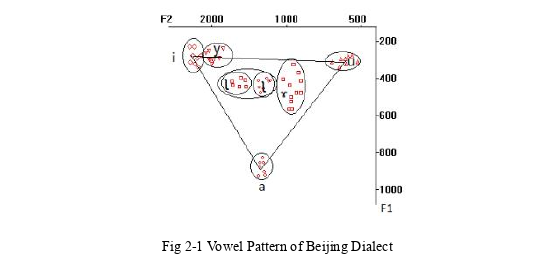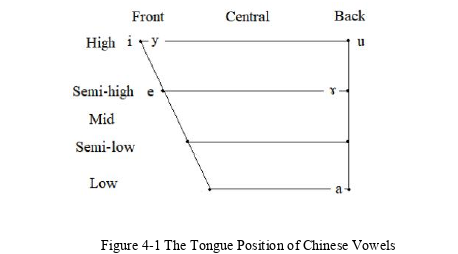本文是一篇德语论文,笔者认为汉语、英语和德语元音之间的差异很难区分,这可能导致德语(L3)习得过程中的负迁移。基于以上分析和相关章节的研究结果,本文从以下几个方面对德语(L3)教学提出了一些建议:首先,教师可以向学生解释发音的原则和方法。发音的原理和方法可以通过模仿口腔结构来解释,如坚硬的下颌、上齿、下齿,或者通过图片或表情来演示。通过区分相似发音,中国学习者可能不会直接用汉语和英语的相似发音来代替德语发音。
Chapter 1 Introduction
1.1 Research Background
Powered by global economic integration, the researches on language transfer arebecoming more and more popular at home and abroad. As far as existing researches areconcerned, the researches mostly focus on the transfer of Chinese (L1) on the acquisition ofEnglish (L2), which only involve two languages. However, in the current economy andsociety in China, it is not able to meet the requirements for Chinese learners that only masterChinese and English. Faced with such a situation, it is essential to learn a third language forChinese learners on the basis of mastering Chinese (L1) and (L2). Learning a third languageor even more languages has become a big upsurge in today’s society. Under this background,the study of language transfer on third language acquisition has attracted more linguists’attention and has made many achievements.
With the deepening of Sino German cooperation, more and more Chinese learners beginto choose German as their third language. At the same time, some problems appeared in theprocess of German acquisition. For example, what influence do the acquired two languageshave on the acquisition of German (L3)? Which language’s vowels have more influence onGerman (L3) vowels? Chinese (L1) or English (L2)? It is impossible to explain thesequestions based on the previous research results. Therefore, the researchers need to furtherconsider the transfer of English (L2) as well as the transfer of Chinese (L1) on the acquisitionof German (L3).
The previous researchers tended to focus on the transfer of L1 on the acquisition of L3,paying less attention to the transfer of L2 on L3, not to mention the study on vowel transfer ofChinese and English on German vowels. Under this background, this study makes an analysison the vowel sounds of Chinese learners’ German (L3), and investigates the transfer ofChinese ( L1) and English ( L2) vowels on German (L3) vowels by adopting the experimentalmethod.
1.2 Research Purpose and Significance
Taking Chinese students whose L2 is English and L3 is German as subjects, this studyuses the method of speech experiment to analyze their German vowel pronunciation, with theaim of exploring the transfer from L1 and L2 vowels on L3 German vowel sounds. Through finding out the transfer causes and putting forward suggestions for teaching and learning, thestudy aims to fully promote positive transfer and inhibit negative transfer in the future processof German vowel sounds acquisition.
This study has both theoretical and practical values.
In terms of the theoretical values, the study may provide new insights and conclusionsfor further researches of third language acquisition. The findings of this study are expected todeepen and widen the researches of German (L3) teaching.
In terms of the practical values, the study has positive meaning for both teachers andlearners. On the one hand, some implications are put forward to help German teachers graspthe key and difficult points in the process of German (L3) acquisition. On the other hand, theresults of the study may provide some suggestions for Chinese learners to make full use of thepositive transfer and overcome the negative transfer in the acquisition of German (L3) vowelsounds.
Chapter 2 Literature Review
2.1 Related Concepts
2.1.1 Language Transfer
Language Transfer is a term originated from the category of psychology, referring to theinfluence of learners’ acquired knowledge and skills on the new knowledge and skills.
As early as 1881, Whitney (1881) used “Language Transfer” to express the influencescrossing different languages. But in the academic circle, a term of “Interference” put forwardby Weinreich (1953) was often mentioned instead of “Language Transfer” in early studies.“Interference” only focused on the negative transfer of mother tongue. However, in fact,learners’ mother tongue also had a positive effect on target language acquisition. Gradually,the term “Language Transfer” gradually replaced “Interference”, and was widely used inthe academic field.
The definition of “Language Transfer” was given by Odlin (1989:27) in his bookLanguage Transfer: Cross-linguistic Influence in Language Learning: “Transfer is theinfluence resulting from similarities and differences between the target language and anyother language that has been previously (and perhaps imperfectly) acquired.” Threeconclusions were drawn from his definition. First of all, “Language Transfer” not justmentioned to the influence from learner’s mother tongue, it could also refers to the influenceof any other language acquired by learners on the process of new language acquisition.Secondly, “Language Transfer” included the influence of L1 on L2 acquisition and thetransfer of L2 on L1 as well, which meant, the crossing language interaction would occurbetween two languages. Thirdly, positive transfer and negative transfer were two types oflanguage transfer from Odlin’s definition. The transfer caused by the commonness betweenthe acquired language and target language is called positive transfer, which may promote theacquisition of target language. On the contrary, errors caused by learners’ incorrect used ofacquired language knowledge in the acquisition of the target language is called negativetransfer.
2.2 Related Studies of Language Transfer on Third Language Acquisition
2.2.1 Foreign Studies of Language Transfer on Third Language Acquisition
The study of language transfer on third language acquisition originated in the 1980s andhas attracted scholars’ attention. Sharwood Smith (1994) proposed a term named“Interlanguage Influence”, which is often used as the superordinate of “Language Transfer”,involving mother tongue transfer, interlanguage, and even the reverse transfer ofinterlanguage to mother tongue. Interlanguage Influence is defined that in the process of thedevelopment of target language, not only mother tongue will have an impact on learners’behavior, but also any other language that learners have acquired will have an impact ontarget language. As a result, language transfer is no longer limited between L1 and targetlanguage, thus the study of language transfer on third language acquisition has graduallycome into the public view.
The beginning of researches on third language acquisition is the study conducted byRingbom (1987) which analyze the influence of Finnish (L1) and Swedish (L2) on theacquisition of English (L3). Nowadays, the study of third language acquisition has been paidmore attention and the results have shown that both learners’ L1 and other foreign languagescould affect the acquisition of new languages (Cenoz, 2000, Ringbom, 1987, 2001).

Chapter 3 Research Methodology....................................10
3.1 Research Questions.................................. 10
3.2 Partipants involved and Materials used...................................10
3.3 Research Parameters Measured....................................12
Chapter 4 Results and Discussion..................................14
4.1 Chinese, English and German Vowel Systems............................... 15
4.1.1 Chinese Vowel System................................16
4.1.2 English Vowel System............................... 16
Chapter 5 Conclusions.......................... 40
5.1 Major Findings.................................. 40
5.2 Implications.........................................41
Chapter 4 Results and Discussion
4.1 German, Chinese and English Vowel Systems
The three factors of the height of tongue, the anteroposterior position of the tongue, andthe spread of the lips could determine the types of each vowel. The analysis of vowel systemis mainly based on these three aspects, which is benefit to understand the pronunciationcharacteristics of languages.
Firstly, the height of tongue position is related to the size of the opening of the lips: Thelarger the mouth opening, the lower the tongue position. The smaller the mouth opening, thehigher the tongue position.
Secondly, in terms of the anteroposterior position of the tongue: When produce the frontvowel, the lingual lobe is extended forward, with facing the hard front part; When produce theback vowel, the lingual lobe shrinks back, with the posterior part rising up; When produce thecentral vowel, the protuberant part of the lingual lobe is in the middle, which is facing themiddle of the hard jaw.
Thirdly, the spread of the lips: When pronouncing vowels, those with loose lips arecalled unrounded vowel, while those with round lips are called rounded vowel.
According to the above three factors, a vowel tongue bitmap could be drawn aiming toprovide an objective basis for comparison when determining and describing the tongueposition of the vowels. Besides, the vowel system may be clearly displayed in the voweltongue bitmap.

Chapter 5 Conclusions
5.1 Major Findings
Based on the above analysis, the major findings are manifested in the following aspects:1. Firstly, based on Flege’s Speech Learning Model, the eight German basic vowels [a:],[i:], [u:], [y:], [e:], [o:], [ε:], [ø:] could be classified as the following categories: [a:, u:, y:];[o:, ø:] ; [ε:] ; [e:]. In addition, German [i:] is affected by the positive transfer.
In terms of the first category: very similar sounds [a:, u:, y;]. The pronunciation ofGerman [a:], [u:] are very similar with the sound of Chinese [a], [u] and English [a], [u], andthe sound of German [y:] is very similar with that of Chinese [y]. Among them, theacquisition of Chinese learners’ German vowel sound [a:] is mainly affected by the negativetransfer of English vowel [a]. Moreover, it could be seen that Chinese learners’ tongueposition of German [a:] is higher and more forward than that of German native speakers; Thepronunciation of Chinese learners’ German [u:] could be affected by the negative transfer ofthe very similar vowel [u] in English, resulting in the phenomenon that Chinese learners’tongue position is more forward and higher than German native speakers’. Moreover, themouth shape is not as rounded as German native speakers’. Chinese learners’ pronunciation ofGerman vowel [y:] is influenced by the negative transfer of Chinese vowel [y], and Chineselearners’ tongue position is higher than that of German native speakers.
In terms of the second category: slightly different sounds [o:, ø:]. There are slightdifferences between the pronunciation of German [o:] and that of English [ɔ]. In addition, thepronunciation of German [ø:] is slightly different from Chinese [y]. Among them, German [o:]produced by Chinese learners is affected by the negative transfer of the slightly differentvowel [ɔ] in English. And the tongue position of Chinese learners is more backward than thatof German speakers, with the rounder shape of the lip. The pronunciation of Chinese learners’German [ø:] is affected by the negative transfer of Chinese [y]. As a result, Chinese learners’tongue position of German [ø:] are more higher and more forward than that of German nativespeakers.
reference(omitted)
